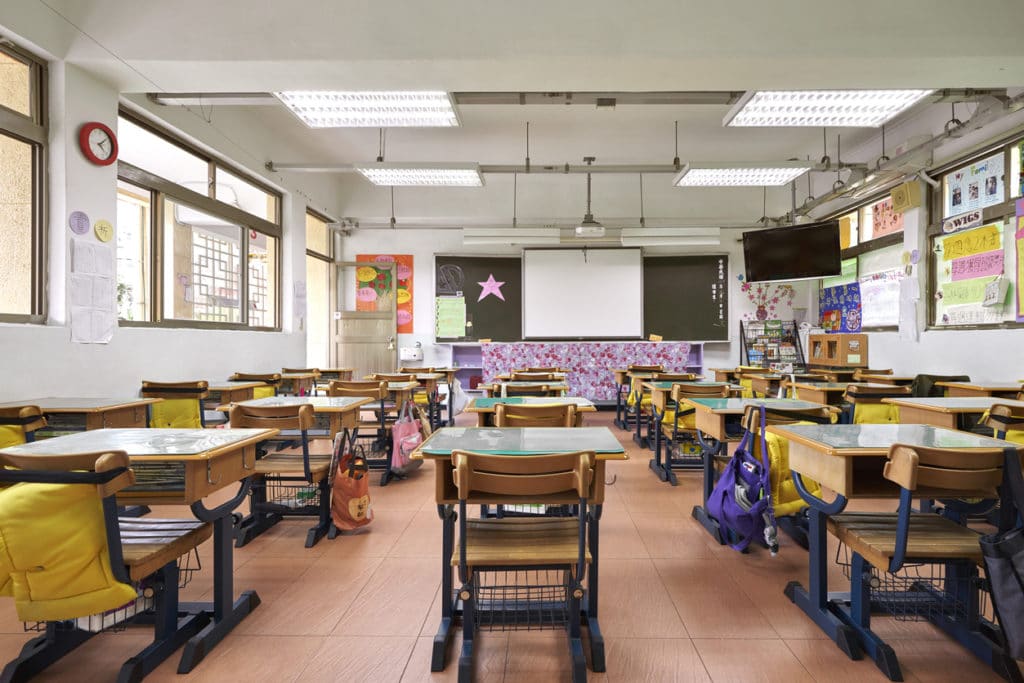
Classroom lighting can have a significant impact on learning and overall productivity. Although decades of research suggest standard fluorescent lights are far from ideal, most classrooms have the same harsh, unforgiving overhead lights that have plagued schools for generations.
Even in districts transitioning to energy-saving LEDs, teachers are still searching for creative ways to personalize their space while creating a comfortable learning environment for their students. Whether you’ve been investigating your options for weeks or are just getting started, you’ve likely considered modifying your classroom lighting with colored fabric or decorative light covers.
Maybe you’ve even imagined how impressed your students and coworkers might be once you’ve covered your unattractive ceiling panels with a gorgeous landscape or clouds. If you’re simply trying to modify the esthetics of the room, decorative panels can help. However, light covers for classrooms that have blue sky and clouds don’t provide any more benefits than looking nice.
If you’re looking for a way to improve the quality of the lighting in your classroom, and transform the atmosphere in a way that could have a meaningful impact on the lives of your students, you can do better. Instead of covering your fluorescent lights with images that might complement a theme, consider how your students could benefit from light filters that transform harsh overhead lights to a healthier, more natural light, white light.
Why So Many Educators Are Modifying Their Overhead Classroom Lighting
Natural white light radiates all the colors of the electromagnetic spectrum with uniform intensity. The artificial lights found in most classrooms disburse a narrow range of visible light of varying color temperatures. Based on what the research shows so far, spending hours each day under the glare of fluorescent lights and harsh LEDs can negatively impact:
- Moods and emotions
- Visual Acuity
- Hormonal Regulation
- Anxiety Symptoms
- Focus and Retention
- Overall Classroom Performance
A study conducted in the early 1990s found that students were less focused in classrooms lit with fluorescent tubes than environments illuminated with sources more closely resembling natural daylight. A similar investigation decades earlier suggested students subjected to standard classroom lighting were less attentive in class while noting a strong connection between “radiation stress” and hyperactivity.
A Simple Classroom Lighting Solution with Multiple Classroom Benefits

As you contemplate the value of improving the quality of the light in your classroom, consider for a moment how the bulbs in your overhead lights work. Let’s start with fluorescent tubes. When you flip the light switch, the electrical current excites the mercury vapors. The interaction between electricity and mercury creates short-wave ultraviolet light. But it’s not the UV radiation you see.
Fluorescent tubes emit visible light which is the result of the glow created when UV rays interact with the phosphorous coating inside. Although there’s no mercury in LEDs, they still emit UV radiation. In a report published in 2011, investigators determined that artificial indoor lighting increases the risk of UV-related eye disease by as much as 12 percent.
But that’s just the beginning. Both types of indoor lighting flicker, and neither option produces true white light. In fact, cold, white LEDs emit high concentrations of blue light, the wavelength shown to increase the risk of eyestrain, dry eyes, light sensitivity (photophobia), and more. To better understand how your students could benefit from transforming the light illuminating your classroom, consider the potential impact of the following observations.
Unfiltered Light Can Disrupt Sleep Cycles
Sleep quality has a profound impact on memory and learning. Yet, 25% of young children have difficulty sleeping or experience excessive daytime sleepiness. The statistics for children diagnosed with ADHD (attention deficit hyperactivity disorder) are even more alarming. As many as 70% have mild to severe sleep issues. So, what does that have to do with your classroom lighting?
More than most educators realize, the areas of the brain regulating melatonin production and sleep cycles rely on exposure to daylight and darkness. Prolonged exposure to fluorescent (and LED) lighting can interrupt the natural circadian rhythms regulating student sleep cycles by delaying the production of melatonin.
Without enough melatonin in their system, your students could be heading off to bed at a decent hour, yet unable to fall asleep. If their young bodies are still producing melatonin in the morning, they’ll still be sleepy early in the day instead of feeling well-rested and ready to learn.
Fluorescent Lights Can Amplify the Impact of Stress
Melatonin isn’t the only hormone that can be inhibited by the color temperature of your classroom lighting. Overhead lights that interfere with sleep cycles can also inhibit cortisol production, the hormone responsible for the fight or flight response triggered by stress. Not only is cortisol directly involved in stress regulation, but the hormone is also essential for:
- Consistent Energy Levels
- Metabolizing Glucose
- Regulating Blood Pressure
- Reducing Inflammation
- Utilizing Carbohydrates and Fat
Although you might naturally assume having less cortisol coursing through their veins might benefit at least a few of your students, cortisol suppression makes it far more difficult for young bodies to manage the physical and emotional requirements of student life. Cortisol suppression has been linked to increased anxiety levels, poor overall classroom performance, and even symptoms of depression.
The impact can be considerably more pronounced if there is little natural sunlight in your classroom. Students sensitive to cortisol suppression often have less energy a more difficulty concentrating as the day progresses.
The Absence of Natural Light Could Trigger Seasonal Depression
Many students have problems with concentration, energy levels, and irritability during the cold, dark winter months. Severe symptoms could be a sign of seasonal affective disorder (SAD). Although more common in teens and adults, SAD can affect classroom participation, schoolwork, and test scores. Students living with this form of depression might also experience any number of the following symptoms:
- Feeling Sluggish or Disengaged
- Difficulty Sleeping or Concentrating
- Feeling Agitated or Depressed
- Feeling Hopeless or Worthless
- Loss of Interest in Favorite Activities
Many researchers believe SAD is triggered by a gradual decline in the production of two essential neurotransmitters: melatonin and serotonin. They are produced in response to natural white light. While seasonal, it’s important not to lose sight of the fact that SAD is a serious form of depression not typically diagnosed until symptoms persist for two weeks or longer.
However, even students experiencing mild, short-term symptoms could benefit from classroom lighting that mimics the impact of natural sunlight.
Better Alternative?
What light covers provides the highest quality light for classrooms?
Healthier Options for Classrooms
Transformative Covers Could Help Students Living with ADHD
Nearly 10% of children between the ages of 3 and 17 are diagnosed with attention deficit hyperactivity disorder (ADHD). Current statistics show that nearly twice as many boys are affected in comparison with the girls. For a child to be diagnosed, impulsivity, inattention, and signs of hyperactivity must be long-lasting and severe enough to cause a lag in some aspect of development.
There’s no cure for ADHD. However, many students take medications to help manage symptoms and/or work with a therapist to help with social, behavioral, and emotional concerns. With treatment, many students outgrow the condition by adulthood.
Although researchers investigating the impact of artificial lighting found a direct correlation between unshielded fluorescent lights and an increase in fidgeting, wandering attention, and impulsivity decades ago (1979), relatively few educators are aware of the many ways a simple fluorescent light filter could help students diagnosed with the disorder.
Flickering Overhead Lights Can Overwhelm Some Students
Once educators know what to look for, they’re often able to pinpoint some of the many difficulties fluorescent lights can inflict upon students with certain medical conditions. Although many improvements have been made to help suppress the audible hum of fluorescent tubes, even today’s “flicker-free” fluorescent lamps and LED bulbs send chaotic signals to the brain.
While hardly perceptible to most, many students living with autism spectrum disorders find the effects too overwhelming to ignore. Classroom challenges are similar for youngsters living with photosensitive epilepsy. Students affected by the neurological disorder are most often impacted by lights that flicker 5-30 times per second. The more contrast in the student’s field of vision, the higher the risk of a seizure.
Some Students React to Indoor UV Exposure
Although some students are impacted by the chaotic visual input of flickering lights, others are more susceptible to symptoms triggered by indoor UV exposure. UV light increases the likelihood of disease flares for students living with lupus because of the way their immune systems respond to the cellular damage caused by ultraviolet radiation. Once their immune systems are triggered, symptoms can persist for days or weeks at a time.
As their immune systems target otherwise healthy tissues, young people living with the autoimmune disorder often experience overwhelming fatigue, joint pain, digestive disturbances, and uncomfortable skin rashes. With up to 70% of lupus patients reporting UV exposure causes symptoms to flare, the Lupus Foundation of America recommends covering fluorescent fixtures, LEDs, and halogen bulbs with UV-blocking filters.
Are You Ready to Transform Your Classroom Lighting?
The décor in your classroom helps your students feel comfortable, welcome, and ready to learn. While you could cover your overhead lights with a decorative panel, the thrill of a cosmetic upgrade is fleeting. Instead, consider gifting your students (and yourself) with light filters that transform the limited color spectrum of LED and fluorescent lights to healthy, white light.
For the most advanced UV-blocking light covers in the industry, visit Make Great Light. Our NaturaLux™ tube filters and light covers are affordable, easy to install, and designed to mimic the full-spectrum light of the mid-day sun.